#BecomingBioDiverse
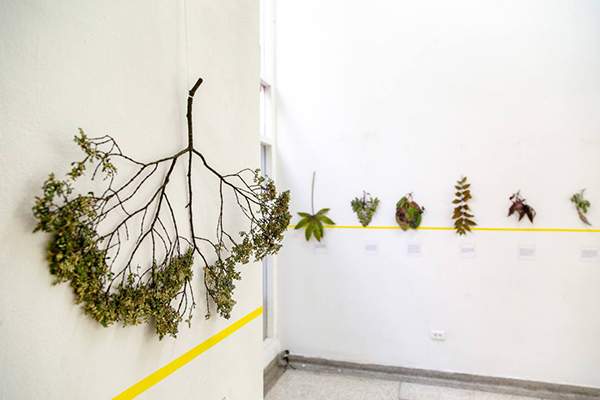
Photograph by Felipe Villegas. Instituto de Investigación de Recursos Biológicos Alexander von Humboldt. Image courtesy of the author.
Colombia is one of the most biodiverse countries in the world. According to Colombia’s Biodiversity Information System (SiB Colombia), the country has 51,330 species, including 1,909 species of birds, 528 species of mammals, and 1,521 species of freshwater fish. Colombia ranks second in the world in terms of biodiversity. Its territory is an interweaving of different ecosystems that favors a profusion of life, much of it endemic. However, many of these species are threatened by a variety of human-influenced factors: from the expansion of the agricultural frontier and intensive ranching to the effects of global warming on ecosystems.
Humans are also protagonists in the production of life as “diverse,” at least in its existence as data. Biodiversity requires the cataloging, comparison, identification and counting of the living. Without these activities, it would be impossible to state the figures mentioned above. Furthermore, without these data, it is not possible to say that Colombia ranks first worldwide in the number of orchid and bird species, second in the number of plants, amphibians, butterflies and freshwater fish, third in the number of palms and reptiles species, and fourth in the number of mammal species.
Biodiversity is the result of scientific practices of ordering, cataloging, and counting. In this text, we present a reflection generated by an artistic intervention that proposes a dissonant dialogue with biodiversity sciences. We wonder about the kind of results that art and science can produce if they relate in a dissonant way. Rather than offering conclusions, we want to feel the way in which dissonance can open up new aesthetic and analytical possibilities for all those interested in the relationships between life and science.
#ExistenceIn(Re)Search
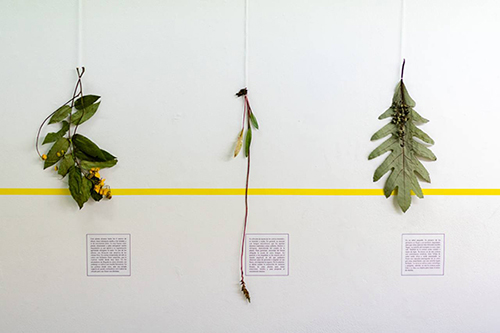
Photograph by Felipe Villegas. Instituto de Investigación de Recursos Biológicos Alexander von Humboldt. Image courtesy of the author.
Recording is one of the most basic tasks to account for biodiversity. Without records that can be computed, cleaned, stored, and subjected to all kinds of algorithms, one could not report that Colombia has 1,909 species of birds or 528 species of mammals.
Recording requires taxonomic classification. The species is the basic unit when quantifying biodiversity, and the species is not possible without taxonomy. Taxonomy, in turn, is the result of the comparison between specimens in a collection or museum. In this way, Colombia’s biodiversity is in its forests, rivers, mountains, seas, etc., as well as in the museum collections that keep the specimens collected in the country.
The Alexander von Humboldt Institute preserves one of these collections. In Villa de Leyva, this institution is home to thousands of carefully preserved specimens. In drawers and jars, they are arranged by scientists according to the species allowing the comparative exercise which defines a new species, and identifies samples from all corners of the country. To open the boxes of specimens, the drawers of bird skins, or the jars of frogs preserved in formalin is to find mostly uniform groups, collected at different times and places. These groups remain together thanks to the box, the drawer, the jar, and the taxonomic exercise made by a diverse group of scientists. As the drawer puts into action the existence of a similar type among specimens collected at different times and places, the drawer and its contents make up the material of the species (Martínez Medina and Hernandez, 2020). Therefore, this type, the species, seems to transcend its multiple locations and times thanks to the box and the drawer.
#OrderedEncounters
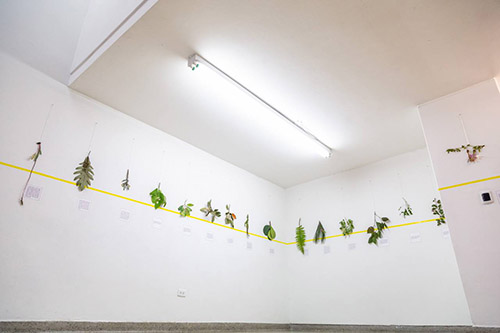
Photograph by Felipe Villegas. Instituto de Investigación de Recursos Biológicos Alexander von Humboldt. Image courtesy of the author.
Ordering produces what is ordered. At the same time, that order considers in detail a long series of characteristics of what it orders. We can think of science and nature as the results of that intra-action (Barad, 2007). Contrary to interaction, intra-action does not suppose pre-established bodies that then participate in a relation with each other. Intra-action also understands agency as not an inherent property of an individual or human to be exercised, but as a result of the relations from where entities emerge. It is precisely through these relations that the network of scientists, institutions, technologies, and practices produce one of the most biodiverse countries in the world. Ordering is a continuous process that must be sustained in time and space. The order of the collection, in fact, changes. This process easily adapts to new specimens or to changes in the discipline of taxonomy. Major changes are, however, infrequent.
What would happen if we ordered the specimens differently? What would happen if the information we included about them changed? What would be the effects on the biodiversity that we study, understand, investigate, and feel?
#DiverseSearching
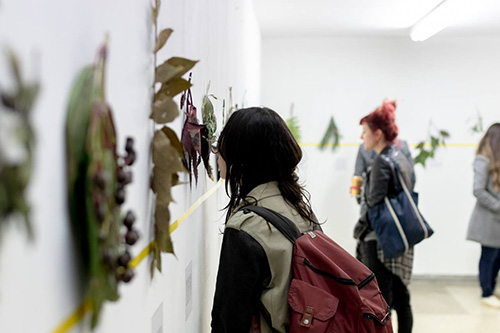
Photograph by: Felipe Villegas. Instituto de Investigación de Recursos Biológicos Alexander von Humboldt. Image courtesy of the author.
Artistic practice provides a way to find a space of freedom where other ways of ordering, relating, and perceiving specimens are feasible. The photographs that accompany this text belong to Suggested Dissonance. Artistic experiment at the in between space, an artistic intervention created by Seila Fernández Arconada that took place at El Parche Artist Residency (Bogotá, Colombia) in July 2019 [1]. The space presented a selection of samples of forty plants and trees collected in Colombia. Hanging from the walls, these plants are crossed by a horizontal yellow line, 130cm high, which reproduces the demarcation commonly used by ecologists who study forests, as part of the “permanent plots” methodology.
Suggested Dissonance experiments with the science of biology. It proposes a space inhabited by what could be an herbarium: plants selected under certain criteria that were partially processed following scientific protocols. Unlike the samples preserved in herbariums, Suggested Dissonance’s plants were pressed for some days so they could partially recover their shape. Also, they were not dried to maintain their original color. In this way, the artist invites us to reflect on the notions of duration and transformation, challenging the purpose of science to produce evidence that “lasts over time.” Arranged on the wall with strings, the specimens present not only a diverse selection of what plant biodiversity of Colombia is, but also a relational narrative based on their connections and differences. Each plant has a description that represents, in itself, a dialogue between diverse kinds of knowledge: from the physical description of the specimen, its properties and traditional uses, to connections with cosmovisions beyond science. There are no names, neither common nor scientific, since they privilege certain links and make others invisible. Categorical mediation gets diluted to make way for other forms of knowing.
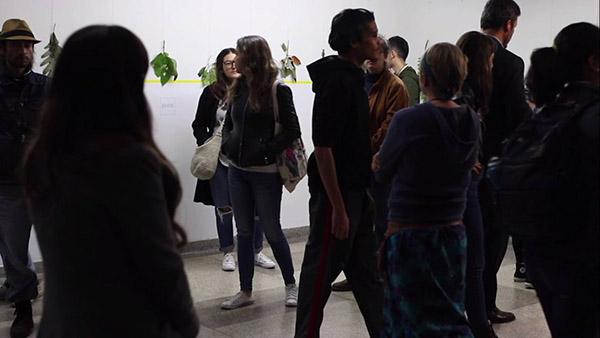
Still from documentary video by Felipe Villegas. Instituto de Investigación de Recursos Biológicos Alexander von Humboldt. Image courtesy of the author.
Contrary to what usually happens in an herbarium, the specimens in Suggested Dissonance preserve their connection with the people, plants, and animals that relate to them in the everyday. The descriptions speak of symbiotic relationships, natural remedies, and beliefs. The texts allow the specimens to relate to each other and to bring them closer to the participants through their attributes. Like the plants, the participants were also selected based on their plural interests—from natural and social sciences to the arts—to be part of this multidisciplinary and multispecies encounter.
#SoundsAndLandscapes
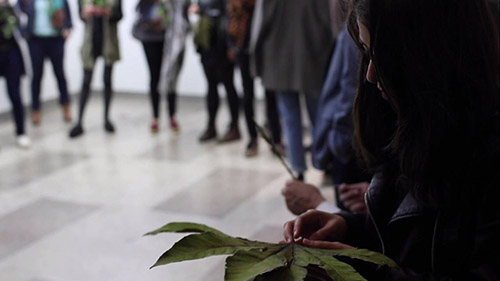
Still from documentary video by Felipe Villegas. Instituto de Investigación de Recursos Biológicos Alexander von Humboldt. Image courtesy of the author.
The immersive experience of this artistic experiment begins when all participants are together in the space. Only then can people hear a soundscape composed of sonic suggestions that elude nature. It includes the sound of wind and low, earthy frequencies, as if coming from the interior of the earth. These sound vibrations are accompanied by a voice, words that invite to reflect and question the Why of this collective ritual. After several minutes of active listening, participants are invited to cultivate their inner plant. They are asked to take a plant that represents them and hang it from their necks. In this way, the specimens move from being contemplated to being active protagonists: they leave the wall (one of the traditional places of visual art) and abandon the texts to merge with the participants.
“You no longer have eyes, nose, ears or tongue, the senses expand to your whole being,” says the voice. Thus, the participants become living organisms, fixed to the ground, realizing their new form and ecosystem.
#SonicPlants
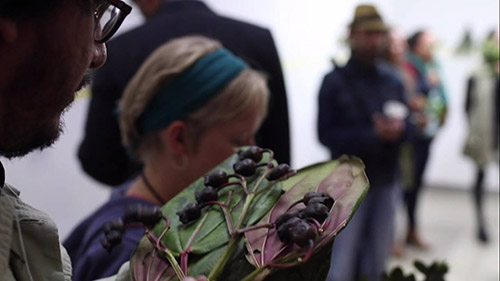
Still from documentary video by Felipe Villegas. Instituto de Investigación de Recursos Biológicos Alexander von Humboldt. Image courtesy of the author.
The written description of the plants is no longer important. Now, the task is to feel the plant allowing affection to expand across the senses. This plant is no longer a plant sample. By challenging conventional ways of articulating a herbarium as an archive, one experiences a being with the plant that dilutes the taxative difference between the person and the plant. Embodied forms of feeling the forest expand, offering transversal questions to the categorical modalities that frame the forest and the society.
“Everyone has already interiorized their plant. It is time to approach its conscience. Try to communicate with others through the sound waves in this space. Take some moment to think of a sound that represents this plant and that can travel as an echo to each one of the entities of this place. This sound seeks to be dissolved and expanded in time and space, so keep that sound as much as your breath allows. And let it merge in a suggested dissonant dialogue.”
This created ecosystem is full of sounds. Some are produced by mouths and leaves, by stems and seeds, as well as by hand palms. It is the sound of dissonance in which humans are with the plant and vice-versa. After a few minutes, the experiment ends. Silence breaks through and allows the transition to a conversation. The plants are still hanging from the people’s necks. Now it is time to listen with a human voice to what those plants might say.
This verbal exchange enabled the participants to account for the diversity of their experiences, which were closely linked to their disciplinary training and previous experiences. We heard Rafael speak of the need to close one’s eyes in order to sharpen one’s senses. Jenny also told us about the feeling of “not knowing” generated by the absence of the plant’s name. In the end, each human participant took the plant s/he was carrying with her/him.
What would happen if a transdisciplinary and multispecies dialogue took the lead on “order” systems? How could a metamorphosis be implemented in the forms and methodologies used to generate and order knowledge? What would be the effects of such a transformation on nature and biodiversity?
References
Barad, K. (2007). Meeting the Universe Halfway Quantum Physics and the Entanglement of Matter and Meaning. Duke University Press.
Fernández Arconada, S. (2019). Paisaje sonoro, Disonancia Sugerida, experimento artístico en el espacio intermedio as part of the project Colombia BioResilience: Biodiversity resilience and ecosystem services in post-conflict socio-ecological systems in Colombia. Presented in El Parche Artist Residency, Bogotá, Colombia.
Martínez Medina, S. y O.L. Hernandez. (2020). “Colecta como captura recíproca múltiple: etnógrafos, científicos y especímenes en clave cosmopolítica”. Revista Colombiana de Antropología, en prensa.
[1] Disonancia Sugerida took place in the scope of the project Colombia BioResilience: Biodiversity resilience and ecosystem services in post-conflict socio-ecological systems in Colombia, a collaboration between the University of Bristol, the University of Exeter (UK) and the Alexander von Humboldt Institute (Colombia), among others.
